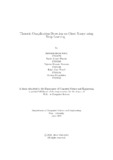| dc.contributor.advisor | Parvez, Zavid | |
| dc.contributor.author | Ratul, Rizwanul Hoque | |
| dc.contributor.author | Husain, Farah Anjum | |
| dc.contributor.author | Purnata, Tajmim Hossain | |
| dc.contributor.author | Pomil, Rifat Alam | |
| dc.contributor.author | Khandoker, Shaima | |
| dc.date.accessioned | 2021-09-09T12:38:31Z | |
| dc.date.available | 2021-09-09T12:38:31Z | |
| dc.date.copyright | 2021 | |
| dc.date.issued | 2021-06 | |
| dc.identifier.other | ID 17101079 | |
| dc.identifier.other | ID 17101166 | |
| dc.identifier.other | ID 17101146 | |
| dc.identifier.other | ID 17101284 | |
| dc.identifier.other | 17101003 | |
| dc.description | This thesis is submitted in partial fulfillment of the requirements for the degree of Bachelor of Science in Computer Science and Engineering, 2021. | en_US |
| dc.description | Cataloged from PDF version of thesis. | |
| dc.description | Includes bibliographical references (page 27-29). | |
| dc.description.abstract | Respiratory or thoracic diseases are one of the leading causes of death worldwide. Many of these diseases can be treated and prevented with proper diagnosis and
early care. The diagnosis of thoracic diseases is mainly done with t. X-rays and other chest imaging techniques and making sense of these require expert radiologists, who aren't always accessible. Especially in underdeveloped countries, a lot of patients with thoracic diseases are left to die due to a lack of proper diagnosis. With the advent of Artificial Intelligence, there have been many initiatives trying to tackle these medical diagnosis problems through the use of n techniques and pattern recognition. Using Deep Neural Networks, patterns corresponding to different thoracic diseases can be easily detected from chest X-rays. In this paper, we have proposed just such a model that can identify the presence of a disease from a range of 14 different thoracic diseases using a Dense Convolutional Neural Network. Our dense convolutional neural network model takes advantage of the sheer amount of data that is now publicly available from chest X-ray datasets. This novel approach works in 2 stages, first training on images from disease-ridden patients alone, and then training the entire network on the whole dataset which includes X-rays from both healthy and unhealthy patients. This allows the model to make better predictions in detecting the presence of diseases as well as the absence. Given a chest X-ray alone, our model can give accurate predictions, with an AUROC mean score of 82.9% competing with the existing state-of-the-art models in this field. | |
| dc.description.statementofresponsibility | Rizwanul Hoque Ratul | |
| dc.description.statementofresponsibility | Farah Anjum Husain | |
| dc.description.statementofresponsibility | Tajmim Hossain Purnata | |
| dc.description.statementofresponsibility | Rifat Alam Pomil | |
| dc.description.statementofresponsibility | Shaima Khandoker | |
| dc.format.extent | 29 pages | |
| dc.rights | Brac University theses are protected by copyright. They may be viewed from this source for any purpose, but reproduction or distribution in any format is prohibited without written permission. | |
| dc.subject | Deep learning | |
| dc.subject | Chest X-ray | |
| dc.subject | Convolutional Neural Networks | |
| dc.subject | Thoracic diseases | |
| dc.subject | DenseNet | |
| dc.subject.lcsh | X-rays | |
| dc.title | Thoracic complication detection on chest X-rays using deep learning | |
| dc.contributor.department | Department of Computer Science and Engineering, Brac University | |
| dc.description.degree | B. Computer Science | |

